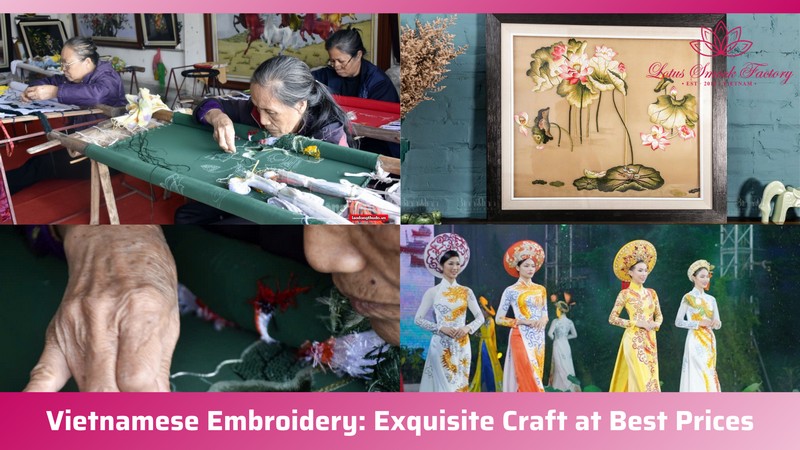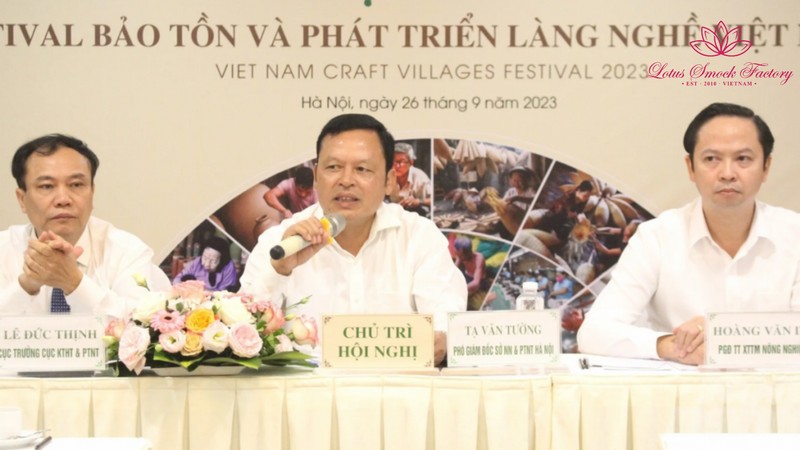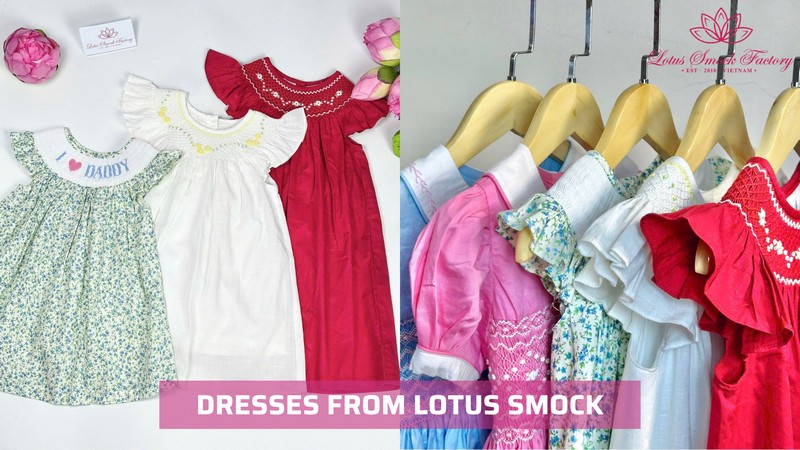Vietnamese Embroidery: The Secret Behind Exquisite Craft at Best Prices
Vietnamese hand embroidery has earned international acclaim for its intricate craftsmanship and affordable pricing. This blog delves into the rich history and artistry of Vietnam’s embroidery industry, uncovering the factors that contribute to its exquisite quality and competitive prices. Let’s explore the secrets behind this traditional craft and its rising global popularity, as known as exquisite craft at best prices.

1. Overview of Vietnamese Embroidery in the International Market
Vietnamese embroidery is one of the most iconic and long-standing traditional arts of the country. With over 1,000 years of history, hand embroidery is not only an integral part of cultural life but also makes a significant economic contribution, especially through garment exports. Vietnam has long been recognized as the cradle of the embroidery craft, with numerous skilled artisans producing intricate handcrafted products. This has solidified Vietnam’s strong position in the international embroidery market, where the products offer not only artistic value but also highly competitive prices.
In 2016, Vietnam became the second-largest exporter of garments globally, just behind China, accounting for 6.09% of the world’s total garment export revenue. This highlights the rapid development of the textile and embroidery industry, especially since Vietnam has one of the largest concentrations of artisans in the world. Compared to other countries where handcrafted embroidered products can be extremely expensive, Vietnamese embroidered items strike the perfect balance between high quality and affordability.
2. Factors Contributing to Exquisite Craft at Best Prices
What makes Vietnamese embroidery unique is the blend of superior artistry and affordable production. Here, we explore the various reasons behind this combination, from skilled labor to abundant local materials and government support.
2.1. Skilled Workforce, Low Labor Costs
One of the key factors behind the competitive pricing of Vietnamese hand-embroidered products is the low cost of labor. Embroidery skills have been passed down through generations, creating a skilled and dedicated workforce. This long-standing tradition helps reduce training costs while maintaining a consistent level of quality in the products.

Compared to other countries in the region, labor costs in Vietnam are significantly lower. For example, labor costs in China have tripled compared to Vietnam, making Vietnam an attractive destination for international businesses seeking high-quality, affordable hand-embroidered products. According to a study, Vietnam ranks fourth in the region in terms of low labor costs, following Cambodia, Myanmar, and the Philippines. This is a significant advantage for Vietnam, attracting numerous international investors in the textile and embroidery industries.
2.2. Abundant and Affordable Local Materials
Another critical factor helping Vietnamese embroidery maintain low prices is the availability of local materials. Fabrics, embroidery threads, and silk are produced domestically, which reduces import and transportation costs. Moreover, the supply chain is well-managed, ensuring both the quality and affordability of materials.
Thanks to optimized supply management and the use of local resources, the Vietnamese embroidery industry can offer beautiful, intricate products while remaining highly competitive in international markets.
2.3. Small-Scale but Flexible Craft Production System
Vietnam boasts a network of traditional embroidery villages spread across the country. Many of these villages, such as Thuong Lam, Thuong Tin, or Quat Dong — the cradle of embroidery — still maintain family-run or small-scale operations. This allows the villages to remain flexible in production, reducing management and operational costs while quickly meeting market demands.
With an abundant and skilled workforce, Vietnam can produce large quantities of hand-embroidered products at low costs without compromising quality. Traditional embroidery skills, passed down through generations, minimize the need for extensive training and optimize productivity when large orders are required. While some technological assistance is applied in certain stages, most processes still rely on human hands to ensure the softness and delicacy of the final product.

2.4. Government and Organizational Support
The Vietnamese government has long recognized the importance of preserving and developing traditional craft villages. Numerous support programs have been implemented to help artisans improve their production processes and increase competitiveness in international markets.
The program “Preservation and Development of Vietnamese Craft Villages 2021-2030” aims to protect traditional crafts at risk of disappearing while promoting the integration of craft villages with tourism, creating jobs and increasing income for local communities. The government also supports small and medium-sized enterprises (SMEs) in accessing international markets through trade promotion programs and subsidies for attending international trade fairs.

3. The Balance Between Quality and Price in Vietnamese Hand-Embroidered Products
Vietnamese hand-embroidered products are renowned for their unique ability to balance high quality with affordable prices. Behind every carefully crafted piece lies a deep cultural heritage and the hands of highly skilled artisans who continue to uphold centuries-old techniques. This section will explore two key aspects that ensure Vietnamese embroidery stands out in the global market: the rich cultural tradition that nurtures the craft and the expertise of Vietnam’s artisans.
3.1. The Rich Culture Nurtured Through Centuries
Vietnamese embroidery is deeply intertwined with the country’s cultural and artistic heritage. Originating over 1,000 years ago, the craft has evolved through various historical periods, influenced by different dynasties, regions, and cultural exchanges. Embroidery in Vietnam isn’t just about decoration; it is a form of artistic expression that tells stories, preserves cultural symbols, and communicates values passed down through generations.

The practice of embroidery has long been associated with elegance and refinement, historically gracing the garments of emperors, scholars, and nobility. Over the centuries, the art form has maintained its prestige while adapting to modern tastes and demands. Vietnamese artisans continue to honor traditional designs while incorporating contemporary aesthetics to cater to today’s global fashion trends. This ability to blend the past and present makes Vietnamese hand-embroidered products uniquely timeless, adding value that goes beyond the visual appeal.
The cultural significance embedded in each embroidered item elevates its quality, making it not just a fashion statement but a testament to Vietnam’s heritage. Buyers of Vietnamese embroidery are not just purchasing a piece of fabric but also acquiring a symbol of the country’s rich history and artistry.
3.2. The Expertise of Skilled Artisans
The exceptional quality of Vietnamese hand-embroidered products is largely due to the expertise of the artisans who create them. Unlike machine-embroidered items, which can often lack nuance, hand embroidery in Vietnam is done with painstaking precision and care. Each piece can take days, weeks, or even months to complete, depending on the complexity of the design. This level of attention ensures that every stitch is placed with intentionality, resulting in products that are both delicate and durable.

These artisans typically begin learning their craft at a young age, inheriting techniques passed down from previous generations. Their hands have been trained to achieve the finest details, creating intricate patterns that are nearly impossible to replicate through mechanical means. The skill set these artisans possess isn’t something that can be taught overnight; it takes years of practice to reach the level of mastery required to produce high-quality embroidered items.
The meticulous craftsmanship is evident in the precision of each stitch and the harmony of the designs. Unlike mass-produced embroidery, where imperfections are common, hand-embroidered pieces from Vietnam showcase flawless symmetry, even in the most intricate motifs. Whether it’s a simple floral pattern or a detailed scene from daily life, each product reflects the artisan’s dedication to their craft.
4. The Importance of Embroidery Exports in Vietnam’s Economy
Exporting embroidered products not only brings substantial income to artisans and craft villages but also contributes to the economic development of rural areas. The embroidery craft provides jobs for thousands of workers while preserving and promoting the traditional cultural values of the nation.
As Vietnam deepens its integration into the global economy, the potential for expanding the market for hand-embroidered products is vast. With the attention and support from the government and international organizations, Vietnam’s embroidery industry will continue to grow, not just in scale but also in quality, propelling Vietnamese embroidered products onto the world stage.

5. Lotus Smock and the Mission to Preserve Vietnamese Embroidery Craft
In the context of the declining traditional embroidery craft, Lotus Smock emerged with a mission to preserve and enhance the artistic value of Vietnamese hand embroidery. Lotus not only focuses on large-scale mass production but also pays close attention to the finest details in each product, ensuring that customers always receive high-quality and intricately crafted items.
Lotus Smock specializes in offering 100% hand-smocked and hand-embroidered children’s clothing. “Hand-smocking” is a time-honored technique that involves creating decorative gathers in fabric by hand, allowing for a flexible yet elegant fit. Combined with meticulous hand-embroidery, these garments become timeless pieces that merge comfort, durability, and artistry.

Smocked clothing is particularly well-suited for children due to its softness and comfort, ensuring that while the garments are beautiful, they are also practical for everyday wear. Lotus Smock prides itself on using the finest materials, such as soft cotton and luxurious silk, ensuring that the clothes are gentle on children’s sensitive skin while maintaining a refined appearance. Each piece is hand-crafted with care, making every garment not just a piece of clothing but a keepsake that parents cherish.
Lotus Smock has become one of the leading brands in the hand-embroidered fashion industry, trusted by many retail partners worldwide. Each product from Lotus is not just a fashion item but also a handcrafted piece of art, deeply embedded with Vietnamese cultural imprints.

Lotus Smock also cares about supporting artisans and craft villages, helping them improve their income and livelihoods. When customers purchase Lotus products, they not only acquire a beautiful item but also indirectly contribute to the preservation and development of Vietnam’s traditional cultural heritage.
Contact Lotus Smock at:
- Facebook: facebook.com/lotussmockfactory
- WhatsApp: +84 83 333 3498
- Youtube: youtube.com/@LotusSmockFactory
Vietnamese hand embroidery, with its combination of a long-standing tradition, a skilled workforce, and government support, has become one of the country’s key industries, contributing not only to the economy but also to promoting national culture globally. Vietnamese hand-embroidered products, especially through brands like Lotus Smock, are not only aesthetically pleasing but also embody distinctive artistic and historical values.

